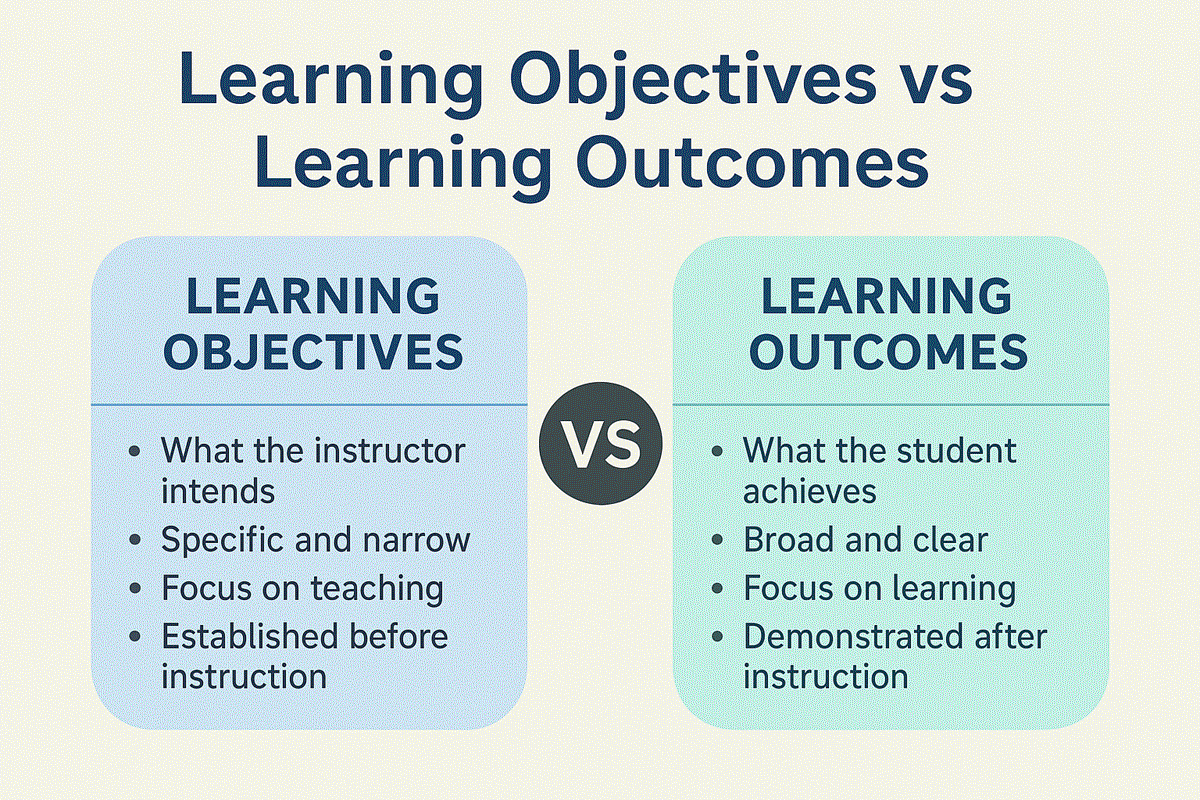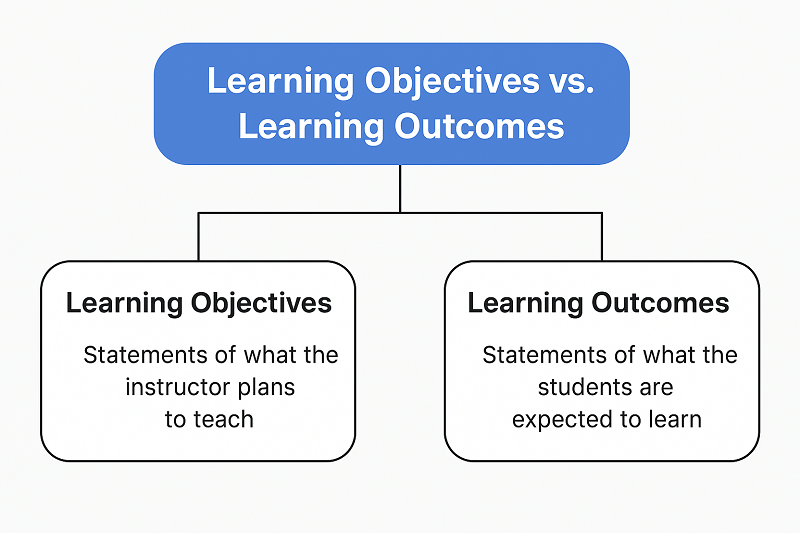
Have you ever walked out of a class or training wondering what you should take away from it? You’re not alone. This confusion often stems from a misunderstanding between learning objectives and learning outcomes. While they might sound similar, they play different educational roles, and understanding those roles makes a real difference.
Learning objectives tell you what the teacher plans to cover, while learning outcomes show what students should be able to do afterward. Is it as simple as that? Yes, but there's more beneath the surface. Using both correctly leads to better planning, clearer instruction, and more meaningful results.
Table of Content
- What Are Learning Objectives?
- What Are Learning Outcomes?
- The Key Differences in Practice
- Why This Difference Essential in Real Classrooms
- Purpose of Learning Objectives
- Purpose of Learning Outcomes
- Writing Effective Learning Objectives Using Bloom’s Taxonomy
- Writing Effective Learning Outcomes: Real-World Examples
- How Objectives Help in Curriculum Design
- How Outcomes Support Assessment and Feedback
- Common Misunderstandings and Mistakes
- What This Means for Students and Teachers
- Conclusion
- FAQs
What Are Learning Objectives?
A learning objective is a short statement describing what an instructor aims to teach during a lesson or course. It’s about intent, not performance.
-
Written from the teacher’s perspective
-
Focused on what will be taught, not learned
-
Uses specific, measurable verbs
For example: “Students will be able to describe the causes of the First World War.”
These objectives guide lesson planning, keeping instruction focused and consistent. According to Anderson and Krathwohl’s revised version of Bloom’s Taxonomy (2001), objectives can be mapped across different levels of thinking—remembering, understanding, applying, analyzing, evaluating, and creating.
What Are Learning Outcomes?
A learning outcome, on the other hand, describes what students are expected to know or do by the end of a learning experience.
-
Focused on the learner’s performance
-
Written from the student’s point of view
-
Observable and assessable
Example: “Students will analyze how political alliances contributed to the outbreak of the First World War in an essay.”
Outcomes show the result of instruction. They’re especially important when evaluating the effectiveness of teaching or determining whether students are meeting academic standards.

The Key Differences in Practice
| Aspect | Learning Objectives | Learning Outcomes |
|---|---|---|
| Focus | Instructor | Student |
| Timing | Before instruction | After instruction |
| Nature | Intention | Achievement |
| Measurement | Process-based | Results-based |
Learning objectives are about the path. Learning outcomes are about the finish line. When educators understand this distinction, they’re better able to design meaningful lessons and evaluate success.
Why This Difference Essential in Real Classrooms
It’s not just a technical detail. When objectives and outcomes are misunderstood or misused, the results can affect every part of the learning process:
-
Lessons become disorganized
-
Students don't know what's expected of them
-
Assessments fail to match what was taught
Research from the OECD’s Education 2030 project points out that clear outcomes are critical in shaping future-ready learners. Students and educators both benefit when there’s no ambiguity in what learning should achieve.
Purpose of Learning Objectives
Learning objectives help teachers plan:
-
What content to include
-
What instructional methods to use
-
How to structure classroom activities
They also help learners know what to focus on during the session. When objectives are well-written, they act like a checklist. Each one aligns with a part of the lesson plan, helping instructors stay on track.
Purpose of Learning Outcomes
Learning outcomes are used to:
-
Evaluate student performance
-
Guide assessments and grading
-
Clarify expectations for learners
They’re especially important for formal education and accreditation bodies like NAAC (India) or CHEA (USA), which require clear articulation of outcomes for quality assurance.
Writing Effective Learning Objectives Using Bloom’s Taxonomy
Start with an action verb, then describe the knowledge or skill to be gained.
Examples by Bloom's Level:
-
Remembering: list, name, recall
-
Understanding: summarize, explain, describe
-
Applying: use, demonstrate, solve
-
Analyzing: compare, differentiate, categorize
-
Evaluating: judge, critique, defend
-
Creating: design, construct, develop
Bad objective: “Students will understand economic growth.” Better objective: “Students will explain three causes of economic growth.”
Writing Effective Learning Outcomes: Real-World Examples
A strong outcome is clear, specific, and measurable. Here’s how it can look:
-
"Students will construct a business plan including budget, target audience, and growth strategy."
-
"Students will evaluate the credibility of online sources in a 500-word report."
Outcomes tie directly to assignments or assessments. If students can't demonstrate the outcome in a meaningful way, it needs to be rewritten.
How Objectives Help in Curriculum Design
Instructors use objectives to map out course content. One common method is called backward design (Wiggins & McTighe, 2005), which works like this:
-
Start by identifying the desired outcomes
-
Design assessments to measure those outcomes
-
Plan lessons that will prepare students for those assessments
With clear objectives, lessons stay focused, materials stay relevant, and teachers avoid wasting time.
How Outcomes Support Assessment and Feedback
Learning outcomes aren’t just useful at the planning stage—they also help educators:
-
Build effective rubrics
-
Give meaningful feedback
-
Track student progress over time
Accrediting agencies like ABET (engineering programs) or global education standards from UNESCO emphasize outcomes as key indicators of learning quality.
Common Misunderstandings and Mistakes
-
Thinking objectives and outcomes are the same
-
Writing objectives that aren’t measurable
-
Using vague language (e.g., “learn about,” “understand”)
-
Forgetting to align assessments with outcomes
When these issues happen, students feel lost, and evaluations become confusing. Clarity solves that.
Real Classroom Scenario
Subject: High School Biology
-
Objective: Teach the process of photosynthesis
-
Outcome: Students draw and label a diagram of photosynthesis, including each step and its function
This clear difference helps both teachers and students know what’s expected.
Challenges Educators Face
-
Limited training in curriculum planning
-
Time pressure to cover syllabus content
-
Difficulty writing measurable outcomes
Solution? Use templates, collaborate with peers, and refer to trusted frameworks like Bloom’s and SOLO taxonomy.
Tools and Models That Help
-
Bloom’s Taxonomy: Great for creating structured objectives
-
SOLO Taxonomy (Biggs & Collis, 1982): Helps measure depth of understanding
-
SMART Goals: Make outcomes Specific, Measurable, Achievable, Relevant, and Time-bound
-
Curriculum Mapping Tools: Help visualize connections between content, objectives, and outcomes
Expert Insights
-
John Biggs (Constructive Alignment): “All aspects of teaching should support students in achieving the intended outcomes.”
-
Linda Suskie (Assessment expert): “Assessment is not about compliance. It’s about improvement.”
These perspectives support the use of clear, intentional design in every lesson.
Global and Policy-Level Importance
From school districts to international organizations, outcomes shape education systems:
-
UNESCO promotes competency-based education that centers on outcomes
-
NAAC requires colleges in India to document and review outcomes
-
OECD links outcomes with employability and long-term success
Learning objectives and outcomes aren't only relevant for teachers—they influence national policy and student futures.
What This Means for Students and Teachers
-
Teachers benefit from structured planning
-
Students understand what’s expected
-
Schools can show evidence of impact and improvement
When students know the goal, they’re more motivated. When teachers know how to measure that goal, they teach with purpose.
Conclusion
The difference between learning objectives and learning outcomes isn’t just technical. It’s practical. One sets the direction; the other marks the achievement. Both work together to shape quality education.
Good teaching starts with clear objectives and ends with meaningful outcomes. When these are in place, learners don’t just go through the motions—they grow with purpose.
FAQs
1. Can learning objectives and outcomes be used together?
Yes. Objectives guide the teaching process, and outcomes confirm if learning happened.
2. What makes a learning outcome effective?
Clarity, measurability, and relevance. It should show exactly what students can demonstrate.
3. Why are action verbs important in writing objectives and outcomes?
They define behaviors that can be observed and assessed.
4. Are learning outcomes only for higher education?
No. They apply to all educational levels, from early childhood to professional training.
5. How can I improve my lesson planning using this knowledge?
Start with the outcome, plan backward, and make sure your objectives build up to it.





